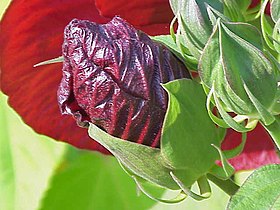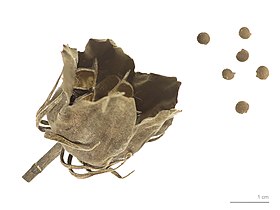Hibiscus moscheutos
| Hibiscus moscheutos | |
|---|---|

| |
| Scientific classification | |
| Kingdom: | Plantae |
| Clade: | Tracheophytes |
| Clade: | Angiosperms |
| Clade: | Eudicots |
| Clade: | Rosids |
| Order: | Malvales |
| Family: | Malvaceae |
| Genus: | Hibiscus |
| Species: | H. moscheutos
|
| Binomial name | |
| Hibiscus moscheutos | |
Hibiscus moscheutos, the rose mallow, swamp rose-mallow,[2] crimsoneyed rosemallow,[3] or eastern rosemallow,[1] is a species of flowering plant in the family Malvaceae. It is a cold-hardy perennial wetland plant that can grow in large colonies. The hirsute leaves are of variable morphology, but are commonly deltoidal in shape with up to three lobes.[4] It is found in wetlands and along the riverine systems of the eastern United States from Texas to the Atlantic states, its territory extending northward to southern Ontario.[5]
Numerous forms exist in nature. It is a tall plant, with a height of 1.5–2.5 metres (4.9–8.2 ft) and flowers up to 20 centimetres (7.9 in) across.[6] Petal colors range from pure white through various pinks to deep red,[7] and most have an eye of deep maroon.[4] Taxonomic consensus is lacking for the nomenclature of the multiple subspecies. The flowers are borne apically, whereas the related Hibiscus laevis carries bud and bloom along the stem.
Ecology
It is a larval host for the
Uses
The edible parts of the plant include its leaf buds and young leaves, flowers, immature seed pods (which can be prepared as okra), seeds, and roots.[9][10]
The leaves and roots are known to contain mucilage. Tea from boiled leaves has been used to relieve cough, sore throat, and digestive inflammation. These medicinal attributes of the tea have been used to treat dysentery, lung ailments, and urinary infections. An infusion of dried stalks has been used to treat bladder infections. Hibiscus moscheutos flowers have also been used externally to reduce swelling and pain from bruises and insect stings.[10]
Cultivation
This is a popular garden plant. It can be propagated by seed, or by crown divisions during winter dormancy, and some success can be achieved by hard-wood stem cuttings. Numerous hybrids of the native North American Hibiscus species have been released by the commercial nursery trade. In cultivation the species or the hybrids can be used in bog gardens or other water features. They are attractive and have wildlife value for nectar-feeders and birds.
Cultivars

Many cold-hardy hibiscus
Conservation
In Canada this plant is listed as a species of special concern under the Species at Risk Act.[2][13]
Gallery
-
Flower bud
-
Fruit and seeds -MHNT
-
White flower
-
Maroon flower
References
- ^ a b "Hibicus moscheutos". NatureServe Explorer. NatureServe. Archived from the original on 2007-09-29. Retrieved 2013-07-04.
- ^ a b COSEWIC 2004. COSEWIC assessment and update status report on the swamp rose-mallow Hibiscus moscheutos in Canada. Committee on the Status of Endangered Wildlife in Canada. Ottawa.
- ^ "Hibiscus moscheutos". USDA Plants. Retrieved 7 December 2023.
- ^ ISBN 9781429014229.
- ISBN 9780660198941.
- ^ "Hibiscus moscheutos / common rose mallow". Royal Horticultural Society. Retrieved 6 December 2023.
- ISBN 9780358106425.
- ^ The Xerces Society (2016), Gardening for Butterflies: How You Can Attract and Protect Beautiful, Beneficial Insects, Timber Press.
- ISBN 978-1-4696-6497-2.
- ^ a b "Swamp Rose Mallow - Hibiscus moscheutos | Washington College". www.washcoll.edu. Retrieved 2023-08-28.
- ^ Winters, H. F. (1970). Our hardy Hibiscus species as ornamentals. Economic Botany 24(2) 155-64.
- ^ Snow, A. A., et al. (2000). Effects of sequential pollination on the success of "fast" and "slow" pollen donors in Hibiscus moscheutos (Malvaceae). American Journal of Botany 87(11) 1656-59.
- ^ *Swamp Rose-mallow. Archived 2013-06-10 at the Wayback Machine Environment Canada: Species at Risk Public Registry.





